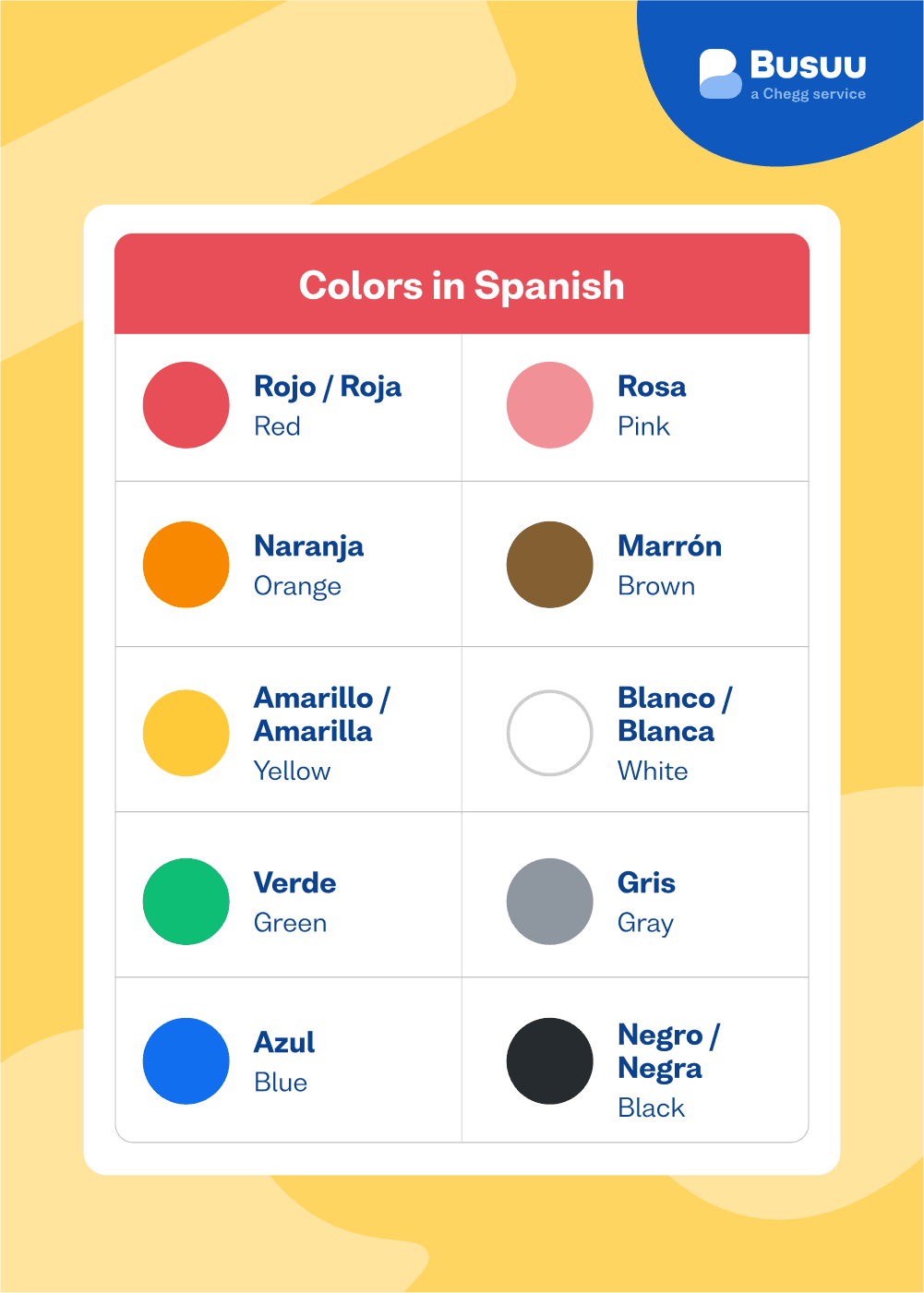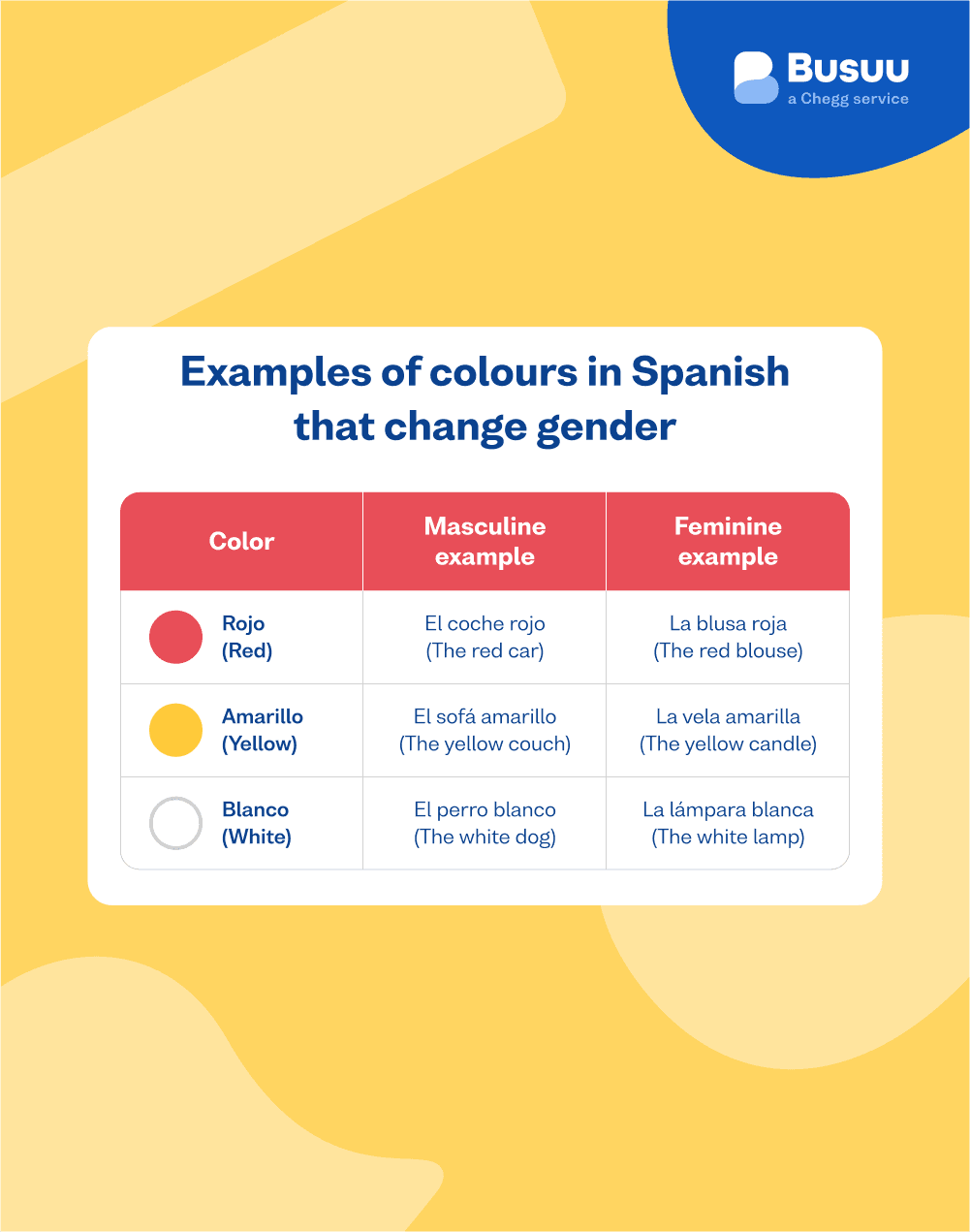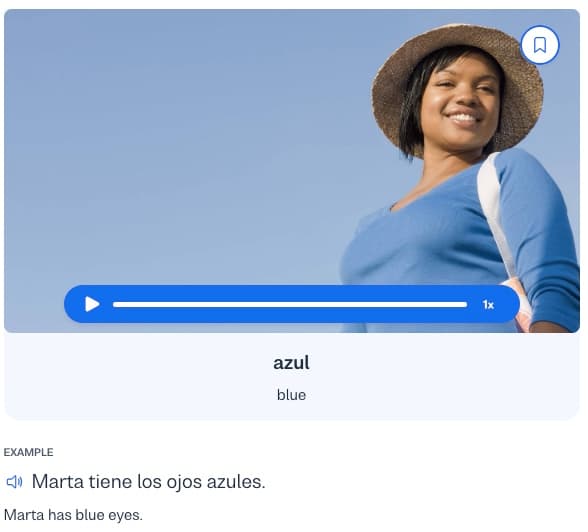I want to learn...
Spanish is a romance language spoken all over the world and one that is fun to learn. One of the first Spanish lessons you learn on Busuu is about colors. Knowing colors in Spanish is really useful when you want to describe objects, point out things or people, and accomplish tasks.
When speaking Spanish with a fluent speaker, you soon realize how necessary it is to know the names of colors and their pronunciation. Knowing colors can help you understand and give directions, appreciate art, and generally be more descriptive when communicating with someone else.
Throughout this article, we will discuss how to say colors and how to use them, and a few grammatical rules when using colors.
How to say “color” in Spanish
Let’s begin with learning how to say the word “color” in Spanish. Color in Spanish is pronounced,co-LOR (color), andco-LOR-ehs (colores)in the plural form. When something iscolored, it iscoloreado; when something is colorful, it is calledcolorido. For a refresher on Spanish pronunciation, check out our article on the topic. It is a helpful reference guide for beginners with sound bites that allow you to practice vowels and tricky consonants in the Spanish alphabet.
Note: Remember that the word color is masculine, so before saying or writing color in Spanish, you will add the “el” in front of it: El color de su camisa es rojo. (The color of his shirt is red.)
Learning colors in Spanish
You might be asking yourself, is it really that crucial to learn so many color names right off the bat? Well, the more colors in Spanish you know, the more your vocabulary and fluency will expand.
Let’s jump right into learning color names!

Colors in Spanish
Pink - Rosa
Orange - Naranja
Blue - Azul
White - Blanco/Blanca
Black - Negro/Negra
Brown - Marrón
Green - Verde
Gray - Gris
Red - Rojo/Roja
Yellow - Amarillo/Amarilla
These, of course, are not all colors, but they are a starting point. Colors in Spanish have both a singular and a plural form, depending on the noun they are describing, and their gender changes in line with the noun.
Colors that don’t change gender
There are exceptions to this rule. The following colors are the same in the feminine and masculine forms and only change from singular to plural:
Azul
Verde
Naranja
Rosa
Gris
Examples of colors changing gender and color that doesn’t change
Below, you will find an example with black (negro / negra) used in the feminine and masculine form and an example with orange (naranja), that does not change:
Table showing examples of colors changing gender
| Spanish | English |
|---|---|
| Estas gafas negras son bonitas. | These black glasses are beautiful. |
| Aquellos móviles negros son muy viejos. | Those black phones over there are very old. |
| El reloj naranja es el mío. | The orange watch is mine. |
Using colors in Spanish in a sentence
Now that we’ve gone over a handful of colors in Spanish with you, let’s discuss how to use them! Just like when you learn numbers in Spanish, knowing colors broadens your vocabulary in such a way that it allows you to ask for things and guidance and gives you more ways to express yourself.
Unlike English, in Spanish, adjectives are generally used after the nouns they modify. This means that when you describe a place, person, object, or thing, you must put the color after the adjective.
Color adjectives in Spanish:
I like this pink T-shirt. - Me gusta esta camiseta rosa.
The orange watch is mine. - El reloj naranja es mío.
Marta has blue eyes. - Marta tiene los ojos azules.
That white mobile over there is very old. - Aquel móvil blanco es muy viejo.
These black glasses are beautiful. - Estas gafas negras son bonitas.
Is this brown wallet yours? - ¿Es tuya esta cartera marrón?
I want that green lighter. - Quiero ese mechero verde.
My grandmother has gray hair. - Mi abuela tiene el pelo gris.
I don’t like this red bag, I prefer hers. - No me gusta este bolso rojo, prefiero el de ella.
This yellow purse is very unusual. - Ese monedero amarillo es muy original.
The influence of gender and numbers on colors
Colors is a fun topic to learn because besides helping you be more clear when asking questions or describing objects, it also enables you to appreciate art and culture differently. Colors throughout Latin America, the Caribbean, and Europe are such influential parts of the culture and define so much about regions, religions, and folklore.
One great example of this is the bold colors used in architecture throughout Latin America. Where in the United States buildings are often gray, brown, and beige, in the Spanish-speaking regions, you will find bright pinks, oranges, and blues.
Although color is so much more than just a descriptive word, it is essential to learn grammatical rules that will help you communicate clearly with Spanish speakers. When used as adjectives, the colors in Spanish match the gender of the thing they are describing. Masculine colors that end in “o” change to the feminine form “a,” when describing feminine nouns.

Colors that change gender
| Color | Masculine examples | Feminine examples |
|---|---|---|
| Red - Rojo | The red car - El coche rojo | The red blouse - La blusa roja |
| Yellow - Amarillo | The yellow couch - El sofá amarillo | The yellow candle - La vela amarilla |
| White - Blanco | The white dog - El perro blanco | The white lamp - La lámpara blanca |
The exception to this rule about colors in Spanish is compound forms. In this case, the color, because it is combined with another adjective, does not have to agree with the noun in either gender or number.
Examples of colors in the compound form
Navy Blue (Azul marino) – El vaso azul marino (the navy blue glass)/La caja azul marino (the navy blue box)
Lime Green (Verde limón) – El refrigerador verde limón (the lime green refrigerator)/La pluma verde limón (the lime green pen)
Another difference between English and Spanish when it comes to color, is that in the plural form, you must add -s or -es to the end of the color word. Here you have examples of colors used in the singular and plural forms to help you understand the rule.
Examples of color changing from singular to plural
A gray sweater. - Un suéter gris.
Gray sweaters - Suéteres grises.
An orange ball. - Una pelota naranja.
Orange balls - Pelotas naranjas
A pink notebook. - Un cuaderno rosa.
Pink notebooks - Cuadernos rosas
Note: A tip we find very useful when describing adjectives with colors in Spanish is to use “de color” before stating the color adjective we are describing. It will simplify use, especially early on, when you’re first getting the hang of it. Because when you use this phrase, it allows you to only ever use the masculine, singular version of the color despite the gender and number of the noun.
Examples of de color
in use
Sweaters are color gray. - Los suéteres son de color gris.
Balls are color orange. - Las pelotas son de color naranja.
Notebooks are color pink. - Los cuadernos son de color rosa.
One final note: Remember that Spanish can vary around the world. Sometimes a word can be different from one country to another. An example of this is “marrón”, which is how you say brown in Europe, but in many parts of Latin America, you will often hear the word “café” used for brown. Check out our article on the difference between Spanish in Spain and Spanish in Latin America if you want to know more!
Use colors when you speak Spanish
This is just the beginning of the advantages you’ll have by mastering colors in Spanish. There are so many more colors we haven’t gone over and could do a whole other article about, but rest assured that you’ve already made gains by reading this article and paying special attention to the colors we went over today and how to use them in a sentence.
Remember that knowing how and when to use the plural form and the correct gender will come with time and practice, and Busuu can help get you to a point where you are comfortable with how to understand gender.
You can check out our article about learning the noun gender in Spanish for reference as well. We hope you’ve had fun learning colors with us, and remember this article is always here for you when you need a refresher on the basics.
Newlanguages


